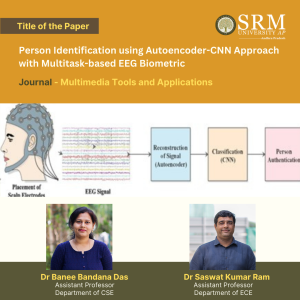 In a remarkable academic achievement, Dr Banee Bandana Das, Assistant Professor in Department of Computer Science and Engineering and Dr. Saswat Kumar Ram, Assistant Professor in Department of Electronics and Communication Engineering, have made significant contributions to the field of biometric security. Their paper, titled “Person Identification using Autoencoder-CNN Approach with Multitask-based EEG Biometric,” has been published in the esteemed ‘Multimedia Tools and Applications journal, which is recognised as a Q1 journal with an impressive impact factor of 3.6.
In a remarkable academic achievement, Dr Banee Bandana Das, Assistant Professor in Department of Computer Science and Engineering and Dr. Saswat Kumar Ram, Assistant Professor in Department of Electronics and Communication Engineering, have made significant contributions to the field of biometric security. Their paper, titled “Person Identification using Autoencoder-CNN Approach with Multitask-based EEG Biometric,” has been published in the esteemed ‘Multimedia Tools and Applications journal, which is recognised as a Q1 journal with an impressive impact factor of 3.6.
This pioneering work showcases a novel approach to person identification using electroencephalogram (EEG) data. The research leverages the power of Autoencoder-CNN models combined with multitask learning techniques to enhance the accuracy and reliability of EEG-based biometric systems.
The publication of this paper not only underscores the high-quality research conducted at SRM University-AP but also places the institution at the forefront of innovative developments in biometric technology. It is a testament to the university’s commitment to advancing scientific knowledge and providing its faculty with a platform to impact the global research community positively.
Abstract
In this research paper, we propose an unsupervised framework for feature learning based on an autoencoder to learn sparse feature representations for EEG-based person identification. Autoencoder and CNN do the person identification task for signal reconstruction and recognition. Electroencephalography (EEG) based biometric system is vesting humans to recognise, identify and communicate with the outer world using brain signals for interactions. EEG-based biometrics are putting forward solutions because of their high-safety capabilities and handy transportable instruments. Motor imagery EEG (MI-EEG) is a maximum broadly centered EEG signal that exhibits a subject’s motion intentions without real actions. The Proposed framework proved to be a practical approach to managing the massive volume of EEG data and identifying the person based on their different task with resting states.
The title of Research Paper in the Citation Format
Person identification using autoencoder-CNN approach with multitask-based EEG biometric. Multimedia Tools Appl (2024).
Practical implementation/social implications of the research
- To develop a personal identification system using MI-EEG data.
- This work is about an Autoencoder-CNN-based biometric system with EEG motor imagery inputs for dimensionality reduction and denoising (extracting original input from noisy data).
- The designed Autoencoder-CNN-based biometric architecture to model MI-EEG signals is efficient for cybersecurity applications.
Collaborations
- IIITDM, Kurnool, India
- National Institute of Technology, Rourkela, India
- University of North Texas, Denton, USA
Future Research Plan
In the future, different deep learning and machine learning methods can be merged to explore better performance in this EEG-based security field and other signal processing areas. We will investigate the robustness deep learning architectures to design a multi-session EEG biometric system.

